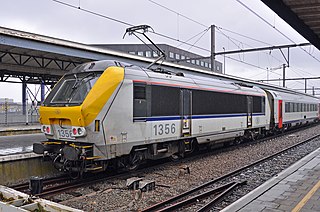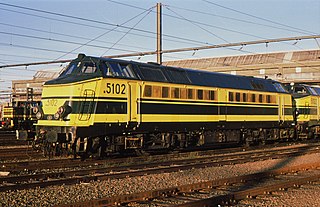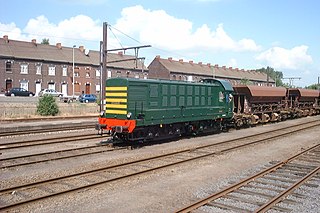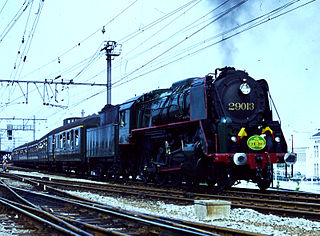The National Railway Company of Belgium is the national railway company of Belgium. The company formally styles itself using the Dutch and French abbreviations NMBS/SNCB. The corporate logo designed in 1936 by Henry van de Velde consists of the linguistically neutral letter B in a horizontal oval.

Line 70 is a railway line connecting Luxembourg City to the south-west of Luxembourg, and on to Belgium and France. The terminus at the north-eastern end is Luxembourg railway station, whilst the terminals at the south are the French town of Longuyon and the Belgian town of Athus. It is designated, and predominantly operated, by Chemins de Fer Luxembourgeois During the 2010 decade, the former line 80 have been merged with this line in order to give the newly created line between Thionville and Longwy via Esch-sur-Alzette.

Class 15 is a type of electric locomotive operated by SNCB/NMBS. The locomotives were originally used for cross-border services TEE services between France, Belgium and the Netherlands, and, like the class 16, they became surplus after the introduction of Thalys and Class 11s. They earned their keep in their last years of service by pulling commuter "P" trains in the Liège area.

The Class 13 are a type of mixed use 200 km/h (124 mph) multivoltage electric locomotive of type Traxis designed by Alstom in the late 1990s for the Belgian and Luxembourgish railways.

The NMBS/SNCB Class 51 is a class of Co′Co′ diesel locomotive formerly used in Belgium.

The Belgian Railways Class 18 was a type of electric locomotive operated by NMBS/SNCB of Belgium. They have been displaced from these workings by Thalys electric multiple units and were all retired from service by 1999. They were derived from the French SNCF CC 40100 express passenger locomotives. Their multi-voltage capabilities allowed them to work beyond Belgium's borders, mainly Paris - Brussels/Liège and Oostende - Cologne.

The NMBS/SNCB Class 77 is a class of 4 axle B'B' road switcher diesel hydraulic locomotive designed for shunting and freight work manufactured at the beginning of the 2000s by Vossloh Schienentechnik/Vossloh Locomotives at the Maschinenbau Kiel plant in Kiel, Germany for the National Railway Company of Belgium (SNCB/NMBS).
Line 80 is a Luxembourgian railway line connecting Rodange to Belgium. It is designated Chemins de Fer Luxembourgeois, but predominantly operated by NMBS/SNCB. The services overlap with those designated as Line 70. On the Belgian side of the border the routes are numbered in the NMBS/SNCB series.

Class 270 locomotives were the first diesel shunters used by NMBS/SNCB. Three were initially ordered as prototypes of diesel-electric traction. Three diesel-hydraulic Class 271 locomotives were also ordered for comparison.

The SNCB/NMBS HLE 18 are a series of four axle Bo′Bo′ multivoltage electric Siemens EuroSprinter locomotives ordered in two batches of sixty in 2006 and 2008.

Fyra was an international high-speed rail service between the Netherlands and Belgium using the AnsaldoBreda V250 train. The service used the HSL-Zuid and HSL 4 railway lines to connect Amsterdam, Schiphol Airport, Rotterdam, Antwerp and Brussels. Continuous technical difficulties suspended the service, and it was eventually permanently halted due to reliability and safety concerns.

The NMBS/SNCB Type 1 was a class of 4-6-2 steam locomotives built in 1935 and 1938 for working heavy express passenger trains operated by the National Railway Company of Belgium (NMBS/SNCB).

The Belgian State Railways Type 7, later known as the NMBS/SNCB Type 7, was a class of 4-6-0 compound locomotives built between 1921 and 1924.

The NMBS/SNCB Type 29 was a class of 2-8-0 steam locomotives built between 1945 and 1946. The class was ordered and used to help revive the operations of the National Railway Company of Belgium (NMBS/SNCB) following World War II. The locomotives were built in Canada and the United States, and supplied to Belgium under the auspices of what later became known as the Marshall Plan.

The NMBS/SNCB Type 26 was a class of 2-10-0 steam locomotives built between 1945 and 1947. Originally commissioned as part of an order for 200 DRB Class 52 Kriegslokomotiven placed by the Deutsche Reichsbahn (DRG) with Belgian locomotive manufacturers in 1943, the 100 members of the Type 26 class were completed for the National Railway Company of Belgium (NMBS/SNCB) following the liberation of Belgium late in 1944.

The Belgian State Railways Type 10, later known as the NMBS/SNCB Type 10, was a class of 4-6-2 steam locomotives built between 1910 and 1914.

The Belgian State Railways Type 23, later known as the NMBS/SNCB Type 53, was a class of 0-8-0T steam locomotives built between 1904 and 1927.

The NMBS/SNCB Type 64 was a class of 4-6-0 steam locomotives built as Prussian P 8s for German railways, delivered as war reparations to Belgium at the end of World War I. 168 locomotives of this type were delivered to Belgium, working mostly on light passenger trains operated by the National Railway Company of Belgium (NMBS/SNCB). The final locomotives of this type were withdrawn in 1967, marking the end of steam service in the country.

The NMBS/SNCB Type 36 was a class of 2-10-0 Decapod steam locomotives built from 1909 to 1914 for heavy freight service in Belgium operated by the National Railway Company of Belgium.
This page is based on this
Wikipedia article Text is available under the
CC BY-SA 4.0 license; additional terms may apply.
Images, videos and audio are available under their respective licenses.

















